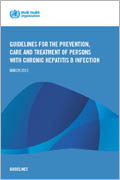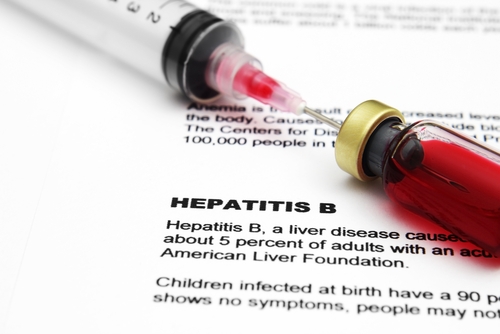The World Health Organization (WHO) has for the first time ever released guidance for chronic hepatitis B treatment. Hepatitis B is a viral infection spread through blood and body fluids of an infected person that attacks the liver. It can cause both acute and chronic disease that results in an estimated 750,000 deaths annually — mostly in low-to-middle-income countries.
Worldwide, an estimated 240 million people are chronically infected with hepatitis B (defined as hepatitis B surface antigen positive for at least 6 months), with the highest rates of infection in Africa and Asia. Eighty to 90 percent of infants infected during the first year of life develop chronic infections, and 30 to 50 percent of children infected before the age of 6 years develop chronic infections. Twenty to 30 percent of adults with chronic hepatitis B infection will develop cirrhosis of the liver and/or liver cancer.
The WHO estimates that approximately 780,000 people die each year from hepatitis B infection — 650,000 of them from cirrhosis and liver cancer due to chronic hepatitis B infection, and another 130,000 from acute hepatitis B, making the disease a major global health problem.
Hepatitis B incidence is highest in sub-Saharan Africa and East Asia, where between five and 10 percent of adult populations are chronically infected. High chronic infection rates are also found in the Amazon and southern regions of eastern and central Europe. In the Middle East and the Indian subcontinent, an estimated 25 percent of the general population is chronically infected. By contrast, less than one percent of persons in western Europe and North America are chronically infected.
A vaccine against hepatitis B has been available since 1982, and is 95 percent effective in preventing infection and the development of chronic disease and liver cancer due to hepatitis B. However, most people who need these medicines have no access them or can only obtain substandard treatment, with one reason for state of affairs being a lack of clear evidence-based guidance for countries (especially low- and middle-income countries) regarding who should be treated and what medicines to use.
The preferred drugs recommended in the guidelines are tenofovir and entecavir, both of which the WHO says have a very low risk of developing drug resistance, are easy to take as one pill once a day, and have few side effects. Both medicines are available as generics, and tenofovir is also used to treat HIV.
“Deciding who needs treatment for hepatitis B depends on a number of factors,” says Dr. Stefan Wiktor, head of the WHOs’ Global Hepatitis Programme. “These new guidelines, which give treatment recommendations that rely on simple, inexpensive tests, will help clinicians make the right decisions.”
 Hot off the press this month, the downloadable 166 page WHO guidelines for the prevention, care and treatment of persons living with chronic hepatitis B infection document (ISBN: 978 92 4 154905 9) lay out a simplified approach to care of persons living with chronic hepatitis B, particularly in settings with limited resources. The guidelines are currently published in English, and complement similar recently published guidance by WHO on prevention, care and treatment of infection due to the hepatitis C virus (HCV).
Hot off the press this month, the downloadable 166 page WHO guidelines for the prevention, care and treatment of persons living with chronic hepatitis B infection document (ISBN: 978 92 4 154905 9) lay out a simplified approach to care of persons living with chronic hepatitis B, particularly in settings with limited resources. The guidelines are currently published in English, and complement similar recently published guidance by WHO on prevention, care and treatment of infection due to the hepatitis C virus (HCV).
The guidance covers the full spectrum of care from determining who needs treatment, to what medicines to use, and how to monitor people long-term, and promote use of simple, non-invasive diagnostic tests to assess the liver disease stage of development and treatment eligibility; prioritize treatment for patients with most advanced liver disease and at greatest risk of mortality; and recommend preferred use of nucleos(t)ide analogues with a high barrier to drug resistance (tenofovir and entecavir, and entecavir in children aged two to 11 years) for first- and second-line treatment. WHO is recommending two types of non-invasive tests to assess the stage of liver disease to help identify who needs treatment. One type is based on blood tests (APRI aspartate aminotransferase [AST]-to-platelet ratio index) and the other is a test based on a scan (Transient elastography e.g. FibroScan).
Recommendations for treatment of HBV/HIV-coinfected persons are based on the WHO 2013 Consolidated guidelines on the use of antiretroviral drugs for treating and preventing HIV infection, which will be updated in 2015.
The WHO says these recommendations will provide opportunities to save lives, improve clinical outcomes of persons living with CHB, reduce HBV incidence and transmission, and help ease the stigma associated with this disease. However, they also pose practical challenges to policymakers and implementers in low- and middle-income countries. Special needs of specific populations, such as people co-infected with HIV, as well as children and adolescents, and pregnant women are also addressed.
“The two recommended medicines are already available in many countries as generics, and thus are relatively inexpensive, costing as little as US$ 5 per person per month. Because for so many people treatment is life-long it is important that patients can access these medicines at the lowest possible price,” says Dr. Wiktor.
The WHO reports that several countries have commenced hepatitis B treatment programme development, and that the organization’s newly-released document also provides guidance on how to organize hepatitis care and treatment services. “For example, countries need to think about ways to improve access to medicines and how best to deliver quality care that builds on existing health services and staff,” says Dr. Philippa Easterbrook of the WHO Global Hepatitis Programme.
While treatment can prolong the lives of persons already infected with hepatitis B, preventing new infections is key, and the WHO recommends that all children be vaccinated against the disease with a first dose given at birth, also noting that some countries, particularly in Asia, have reduced childhood hepatitis B infection rates through universal childhood vaccination programs — the challenge now being to scale efforts up toward ensuring that all children worldwide are immunized from the virus.
Another Hepatitis B infection vector is through reuse of medical equipment, particularly hypodermic syringes. The WHO recently launched a new injection safety program that will also help prevent new hepatitis B infections. The policy calls for worldwide adoption of smart syringes to prevent syringes or needle re-use.
Sources:
The World Health Organization (WHO)

